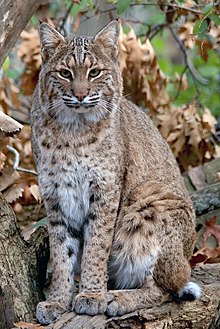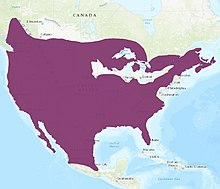
Back Lynx rufus AN وشق كميت Arabic وشق احمر ARZ БагӀараб цӀиркъ AV Uksabol (Lynx rufus) AVK Kürən vaşaq Azerbaijani کورن واشاق AZB Lynx barak BAN Рудая рысь Byelorussian Рудая рысь BE-X-OLD
| Bobcat | |
|---|---|

| |
| Bobcat in Columbus Zoo | |
| Scientific classification | |
| Domain: | Eukaryota |
| Kingdom: | Animalia |
| Phylum: | Chordata |
| Class: | Mammalia |
| Order: | Carnivora |
| Suborder: | Feliformia |
| Family: | Felidae |
| Subfamily: | Felinae |
| Genus: | Lynx |
| Species: | L. rufus
|
| Binomial name | |
| Lynx rufus (Schreber, 1777)
| |

| |
| Range in 2016[1] | |
| Synonyms | |
The bobcat (Lynx rufus), also known as the red lynx, is one of the four extant species within the medium-sized wild cat genus Lynx. Native to North America, it ranges from southern Canada through most of the contiguous United States to Oaxaca in Mexico. It is listed as Least Concern on the IUCN Red List since 2002, due to its wide distribution and large population. Although it has been hunted extensively both for sport and fur, populations have proven stable, though declining in some areas.[1]
It has distinctive black bars on its forelegs and a black-tipped, stubby (or "bobbed") tail, from which it derives its name. It reaches a total length (including the tail) of up to 125 cm (50 in). It is an adaptable predator inhabiting wooded areas, semidesert, urban edge, forest edge, and swampland environments. It remains in some of its original range, but populations are vulnerable to extirpation by coyotes and domestic animals. Though the bobcat prefers rabbits and hares, it hunts insects, chickens, geese and other birds, small rodents, and deer. Prey selection depends on location and habitat, season, and abundance. Like most cats, the bobcat is territorial and largely solitary, although with some overlap in home ranges. It uses several methods to mark its territorial boundaries, including claw marks and deposits of urine or feces. The bobcat breeds from winter into spring and has a gestation period of about two months.
Two subspecies are recognized: one east of the Great Plains, and the other west of the Great Plains. It is featured in some stories of the indigenous peoples of North and Central America, and in the folklore of European-descended inhabitants of the Americas.
- ^ a b c d Kelly, M.; Morin, D. & Lopez-Gonzalez, C.A. (2016). "Lynx rufus". IUCN Red List of Threatened Species. 2016: e.T12521A50655874. doi:10.2305/IUCN.UK.2016-1.RLTS.T12521A50655874.en. Retrieved 24 January 2022.
© MMXXIII Rich X Search. We shall prevail. All rights reserved. Rich X Search
